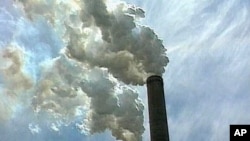More than half the people in the United States are breathing air that could be threatening their health, according to the American Lung Association. The private health group has just released (April 27) its 12th annual State of the Air report, which ranks the quality of the air in U.S. cities and counties in terms of the most common types of air pollution.
The 2011 State of the Air report says 53.3% of the U.S. population - more than 165 million people - suffer pollution levels that the report describes as " too often dangerous to breathe.” Janice Nolen, an assistant vice president at the American Lung Association, says the nation's air pollution has many sources.
“Driving down the highway, turning on the electricity contribute to some of the pollution sources because of the burning combustion, burning coal, burning gasoline or the diesel that is delivering food to our grocery store," she said.
The survey lists 25 major metropolitan areas with the worst air quality. Most of the cities on this so-called "black-list" are in the western state of California.
“They have a lot of people driving their cars. They have a lot of (sea)ports with emissions from the barges and the trucks and the ocean vessels are contributing to that. But they also have geography that keeps the pollution right where it sits, rather than letting it blow to other parts of the country," said Nolen.
The city of Honolulu in Hawaii, and Santa Fe in New Mexico, topped the list of cities with the cleanest air.
The survey's air-quality rankings measured and compared levels of ozone and particulates, the two most common types of air pollution.
Ozone is an invisible reactive gas found up in the upper atmosphere that shields the earth from much of the sun’s damaging ultraviolet radiation. But at ground level, where we can breathe it, ozone is harmful.
When auto and industrial emissions combine with nitrogen oxides in the atmosphere and get heated by the sun, they create ozone pollution, also known as "smog." “Ozone is more widespread but particle pollution is deadlier," said Nolen.
Particle pollution refers to very tiny solid and liquid particles of many different chemicals that are suspended in the air we breathe. It is seen mostly in big cities with coal-fired power plants and heavy diesel truck traffic, such as Chicago, New York and Detroit.
“Air pollution can shorten your life for a lot of reasons," said Nolen.
Nearly 13 million people in the U.S. suffer from asthma, a chronic inflammatory disease of the breathing airways. Air pollution makes asthma worse. People with other severe health conditions - such as heart disease - are also more likely to suffer in polluted air.
Poor air quality can also mean higher costs for health care. Paul Billings directs national policy at the American Lung Association. "Air pollution does kill. Tens of thousands of people in the U.S. die prematurely each year because of elevated levels of particle pollution or soot and ozon," he said.
Even though the report only surveyed the U.S., air pollution is an international concern. Billings says in large cities like Beijing and Mexico City, the problem is severe :
“In fact, in the U.S. if we didn’t have the Clean Air Act we could have that level of air pollution in our large cities," said Bilings.
That 1970 legislation gave the U.S. government the authority to sanction air polluters and set emission standards. But from the beginning, political and corporate resistance has made it difficult to implement.









